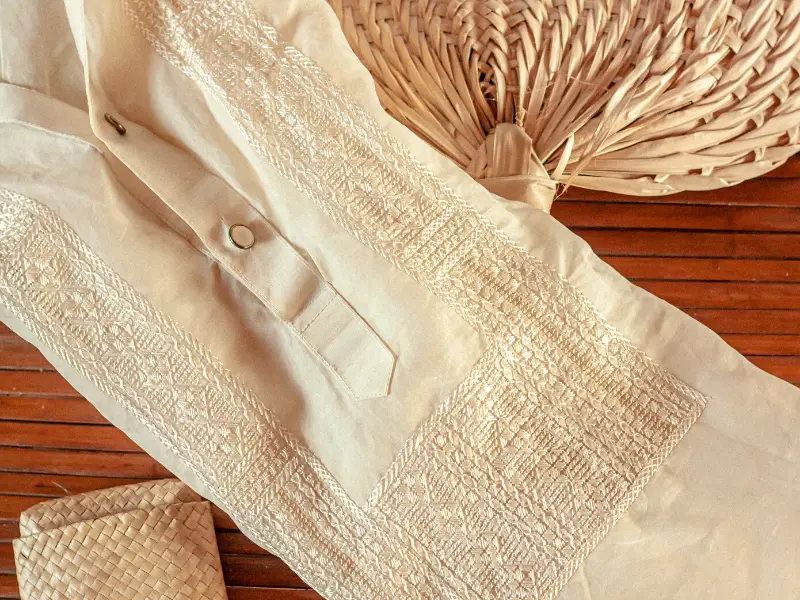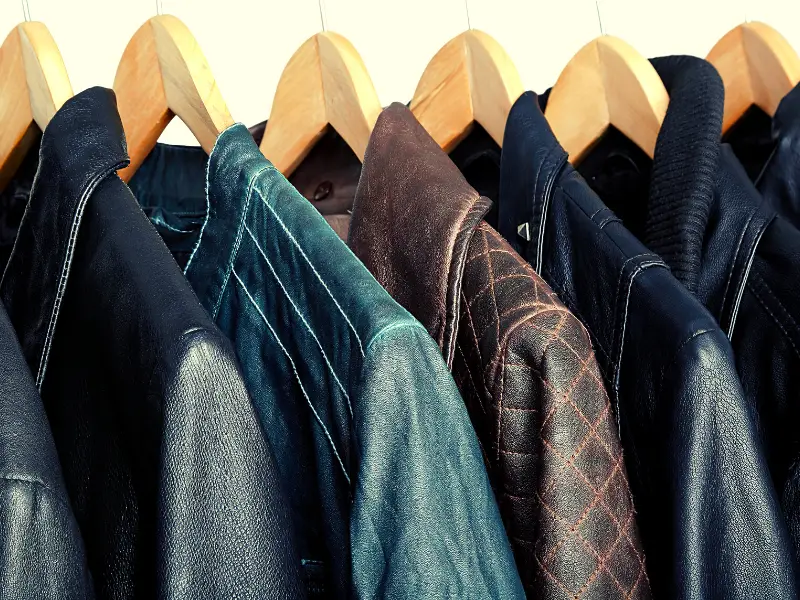As Dr Carmen Hijosa traveled around the Philippines, she discovered the Barong Tagalog, a ceremonial garment often worn by Filipino males traditionally made with the fibers of pineapple leaves.
Its fabric was fine and sturdy, making it ideal for creating the perfect leather alternative. That’s when Piñatex or pineapple leather came to life.

The Eco-Fashion Revolution: Embracing Pineapple Leather and Its Potential
The fashion world has always been one of reinvention and adaptation. As it stands now, there’s a remarkable shift occurring as brands are seeking materials with a lower environmental footprint. This movement is spearheaded by numerous innovations that aim to reduce the fashion industry’s negative impacts on our planet. At the heart of this evolution is the innovative material derived from the pineapple industry – Piñatex®.
Big Brands Making Bigger Changes
Hugo Boss, along with other major players like Puma, exemplifies the seismic shift in the fashion industry towards sustainable alternatives. It’s not just about being on-trend; it’s about fostering responsibility. Embracing vegan leather products such as those made from pineapple leaf fibers demonstrates their commitment to reducing their environmental footprint.
The Natural Advantage of Piñatex®
Piñatex is indeed a marvel, seamlessly blending natural materials into a fabric that’s not only environmentally conscious but also commercially viable. It’s fascinating to understand its composition; the substrate and base material of Piñatex® is crafted from an impressive 72% pineapple leaf fiber and 18% PLA (Polylactic Acid). Not only does this make the material predominantly natural, but under certain industry conditions, it’s also biodegradable.
This material couldn’t have emerged at a better time. Given the vastness of the pineapple industry, an astonishing 40,000 tons of pineapple leaves, which would have otherwise been wasted or burned, now find purpose.
Beyond Fashion: The Versatility of Pineapple Leather
The adaptability of Piñatex extends beyond fashion. Yes, designers worldwide are crafting shoes, bags, and other accessories, but there’s more to the story. Its durability and unique texture make it a favored choice for upholstery, gracing the interiors of cars and contemporary furniture alike.
“Pineapple leather is a material that is not only sustainable, but also stylish and on-trend.”
– Green Matters
A Humane and Sensible Alternative
One cannot discuss Piñatex without highlighting its humane aspects. In comparison to animal leather, Pinatex stands out for being 30% more cost-effective and, most importantly, cruelty-free. No longer do brands have to rely on animal products to achieve that luxurious feel. This material is a testament to the fact that fashion can be compassionate, as it’s entirely free from animal derivatives. The endorsements from entities like PETA and the Vegan Society further cement its place as a genuine alternative.
The Future Beckons
The fashion industry, in its pursuit of materials with reduced environmental impacts, has found a worthy ally in pineapple leather. While fashion historically has had a tarnishing effect on the environment, innovations such as Piñatex are trailblazing a path to a brighter, more sustainable future. It’s a world where style doesn’t come at the expense of our planet.
“Pineapple leather is a material that is not only eco-friendly, but also has the potential to create jobs and boost local economies.”
– Sustainable Brands
Steps to Create Pineapple Leather
To create the pineapple textile, the farmers in the Philippines plantations harvest the pineapple leaves and extract the fibers from them.
After gathering the pineapple, the leaves are separated from the plant’s stem. The fibers are manually removed from the leaves using a scraping method or decoration; the coconut husk is also known for this.
Then, the bundle of cellulose stands is washed in a nearby river and dried on a clothesline. After being waxed to remove entanglements and whipped to remove any remaining plant tissues, the leaf strings are knotted one by one to form a continuous yarn like the traditional procedure used to manufacture abaca fiber.
A kilo of leaves can yield up to 15-18 pieces of white, creamy, lustrous fiber, each measuring approximately 60 centimeters in length. This is a manual, labor-intensive, and time-consuming operation that can involve up to 30 workers.
During this process, the fiber is separated into two types: Bastos, which are strong and coarse and suitable for manufacturing domestic items rugs, and Liniwan, which is excellent for weaving cloth and other fabrics.
When it is ready for weaving, it is up to the trained artisans to wrap and weft the loom to create a simple cloth or one with a pattern on it.

What Are the Materials to Make Pineapple Leather?
Pinatex is typically composed of three different materials. Let’s take a closer look at each of them.
1. Pineapple Leaf Fibers
Pineapple fibers are extracted from pineapple leaves using a method called decortication. The fiber is semi-white and has good tensile strength, making it ideal for producing high-quality leather shoes, boots, and other items requiring strength and water resistance.
2. Polylactic Acid (PLA)
Polylactic acid is the bi-product of plant starch. PLA is a polysaccharide made of lactic acid, which comes from either plant sources or microbial fermentation. It is typically used in manufacturing plastic bottles and other industrial materials, but it can also be used to make Piñatex.

“Pineapple leather is a material that is not only good for the environment, but also for the fashion industry and consumers who want to make a positive impact.”
– Elle
Even while it is a step forward in the development of more sustainable material, and PLA is biodegradable, it still takes a long time for it to decompose by nature.
3. Petroleum-Based Resins
These are used to polish the surface of the product. They protect the fibers beneath them while also enhancing the material’s water resistance and abrasion resistance properties.
How to Clean Pineapple Leather?
Pineapple leather may appear suitable and perform well for several years if it is treated carefully, maintained adequately, cleaned frequently, and stored safely.
If you are using pineapple leather, it is generally recommended to wax the surface with a clear, natural wax every few months or so. In addition, it will improve the strength and longevity of the material underneath by improving the monthly protective finish.
“Pineapple leather is a revolutionary eco-friendly material that is paving the way for a more sustainable future for fashion.”
– Forbes
Pineapple leather can be gently cleaned with a damp cloth because of its finished surface. Make sure the fabric is free of loose fibers and lint, which could cause the surface to get contaminated. A microfiber cloth might be a good option. Also, try in a small area first to ensure that the cloth will not transfer any color to the item’s surface after being cleaned (bag, purse, shoes, etc.).
If additional cleaning is required, a very light brush can aid in the removal of dirt and grime. Slightly dampen it and gently massage it over the leather, taking care not to push too hard. The brush’s hair should be doing the majority of the job.
Following this procedure, wiping it down with a moist cloth can assist in removing any lingering dirt/dust. Allow the item to dry fully before using or storing it.
How to Safely Store Pineapple Leather?
Pineapple leather should be kept cool and dry. Keeping it out of direct sunlight is critical, as the sun’s rays can damage the protective surface.
Putting them in a closet or drawer is an excellent solution if you own pineapple leather bags, shoes, or accessories.
How to Condition Pineapple Leather?
Due to the protective surface treatment applied to pineapple leather, it is not necessary for you to condition it. And, in terms of functionality, you really can’t. The surface finish protects the underlying material, which is often plastic. It also acts as a fence, preventing the conditioner from penetrating the fiber.
Fortunately, the protective surface is a massive relief because it makes it quite simple to clean with a damp cloth. This is a simple method for ensuring that pineapple leather items always look their best. If the surface layer begins to wear away, an extra layer of protectant can be placed to aid in the restoration of the surface layer.

Some of these protectants will be applied using a cloth or applicator, while others will be sprayed and wiped away. Before applying any finish, read the directions carefully and test it on a small area first (to ensure it will not harm the surface) before applying it to the full item.
Author’s Note
Pineapple leather is a booming environmentally friendly and sustainable material. It is also nice to know that it can provide the same level of durability as a non-sustainable material. This kind of vegan leather can be found in many styles and sizes. If you are looking for an environmentally friendly, sustainable material for your bag or shoes, pineapple leather is a great choice!
Find more eco-friendly tips and guides in our article on vegan leather boots, Piñatex, and biotrem.


1 thought on “How to Make Pineapple Leather: An Eco-Friendly & Sustainable Material”